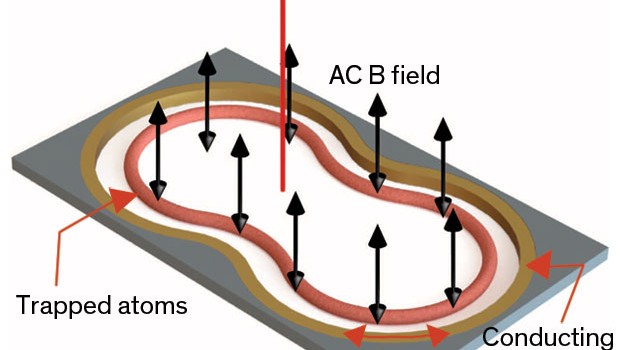A New Kind of Atom Trap Chip for Quantum Computers

Ultracold atoms have long been on the list of potential parts for quantum computers. Early experiments were done with tabletop experimental gear, more recently, but researchers have also designed chips on which these atoms can be trapped and cooled to near absolute zero. (Some such chips even achieved the strange physical state known as a Bose Einstein condensates.) However, even the chip-based traps had to be surrounded by a complicated sets of coils to create the required magnetic field for trapping them.Now a team of scientists at the University of Sussex in Brighton, UK, have come up with a proposal, detailed last week in Nature Communications, to build a better atom trap chip. They show that a conducting loop about 100 micrometers across will allow the creation of a magnetic field that traps the atoms inside the loop. They hope that arrays of such loops could form the basis of a quantum computing chip.
An external microwave field induces a current in the loop, which in turn creates an alternating magnetic field of its own with a different shape. The two fields combine, creating an area close to the conducting loop into which the atoms gather.
“The idea there is that you would have many of these traps, in arrays, which would lend themselves to a kind of memory register for quantum information processing.”
“What is new here is that we are creating a trap…that is close to the surface of the conductor. The important part of the field structure is near the loop wire itself and is acting like a track way or guide,” says Barry Garraway, a theoretical physicist who leads the Sussex group.
The magnetic field, however, is not sufficient by itself to keep the atoms inside the structure and following the conducting loop. To give atoms an extra push, the researchers applied a static field perpendicular to the plane of the conducting loop.
Their first aim for an application is a gyroscope. “The typical approach is that you have the atoms in one part of the circle, you find a method to divide them in two, and send one group around the circle in one direction and the other group in another direction, so they are racing around in clockwise and anticlockwise bunches,” explains Garraway. Where those bunches meet they interfere because of the wave nature of matter. This interference will show as fringes when you image them, he explains. “If the laboratory table has rotated underneath the atoms while they were moving in free flight, these fringes will appear in a slightly different place,” says Garraway.
What about quantum computers? “The idea there is that you would have many of these traps, in arrays, which would lend themselves to a kind of memory register for quantum information processing,” he says. “Right now we are looking at how to store atoms in arrays and lattices.”
Source: spectrum.ieee.org
